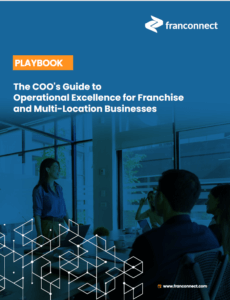Operations management software is transforming how franchise and multi-location businesses handle their most critical challenge: maintaining consistency while scaling. As your brand grows from a handful of locations to dozens or more, the spreadsheets and manual processes that once worked now threaten your expansion with operational chaos.
Today’s franchise leaders find themselves caught in an impossible balancing act of driving growth while ensuring every location delivers the same quality experience. This article explores how purpose-built operations management technology helps eliminate this struggle, assisting brands to escape the reactive firefighting cycle and build standardized, scalable operations that fuel sustainable growth.
The Operational Chaos of Growing Multi-Location Businesses
The journey from 5 to 50 locations creates a perfect storm of operational challenges that can overwhelm even the most organized franchise teams. What worked at five locations (informal processes, founder-led decisions, and spreadsheet tracking) becomes unsustainable as you scale.
Without proper franchise standardization tools, each location becomes an operational island. Managers create their own versions of processes, brand standards get interpreted differently, and customer experiences vary wildly. Brands with fragmented operations typically experience longer location opening times and more compliance issues than those with standardized systems.
The result? Operations leaders spending excessive hours weekly compiling reports instead of coaching performance. Field teams fighting the same fires at different locations rather than preventing them. Franchisees frustrated by inconsistent support. And corporate leadership lacking the visibility to make confident decisions about where to allocate resources for maximum impact.
This operational fragmentation doesn’t just slow growth. It threatens the very foundation of your brand’s promise.
The Real Cost of Operational Fragmentation
Operational fragmentation creates far-reaching consequences that extend beyond daily inconveniences. Most franchise leaders underestimate how deeply these disconnected systems impact their business outcomes.
Customer experience suffers first. When location A follows one process and location B follows another, customers receive inconsistent service, damaging brand trust. The inconsistency becomes immediately apparent to customers who visit multiple locations, eroding confidence in your brand with each varying experience.
Financial implications mount quickly. Manual processes consume significant portions of a location manager’s time, translating to substantial labor costs annually per site. Delayed openings from poor coordination mean lost revenue for each day a location remains closed. Without multi-location operational efficiency, these costs multiply across your network.
Employee turnover escalates when staff members feel unsupported by chaotic systems. Franchisees and managers spending more time on administrative tasks than on coaching team members struggle to build engaged, stable teams. The cycle of hiring and training replacement staff diverts resources from growth initiatives.
Perhaps most concerning are the compliance risks. Brands lacking proper documentation face potential penalties, not counting legal fees and reputation damage from serious breaches.
The hidden cost? Lost growth opportunities.
While operations teams fight daily fires, competitors with streamlined systems outpace them by focusing on strategic expansion rather than maintaining basic operational control.
How Operations Management Software Creates Transformation
Operations management software fundamentally transforms how multi-location businesses function by replacing disconnected tools with a unified system designed specifically for franchise environments.
At its core, business process automation eliminates the manual work that consumes operational teams. Tasks that once required hours of administrative effort, like collecting location reports or tracking compliance issues, happen automatically. Field operations managers can spend more time on strategic initiatives once freed from these administrative burdens.
Centralized document management ensures every location accesses the same, current version of training materials, brand standards, and operating procedures. When corporate updates a process, it immediately reaches all locations, eliminating the “version control” problems plaguing email and paper-based systems.
Location performance tracking capabilities deliver real-time visibility across the entire network. Managers can identify top performers and struggling locations at a glance rather than waiting for quarterly reviews. This visibility allows leadership to spot patterns, highlighting which operational practices correlate with higher sales, better customer satisfaction, and stronger compliance.
Communication tools unite corporate, field teams, and location staff in a single environment. Important announcements reach everyone instantly, while structured workflows ensure critical tasks never fall through the cracks. When issues arise, the system guides proper resolution and documentation.
Perhaps most valuable is the shift from reactive to proactive management. With real-time alerts for potential issues, operations teams address problems before they impact customers or compliance. Predictive analytics even identify which locations might struggle based on early warning signs, enabling preemptive intervention.
For growing brands, this transformation involves more than efficiency. It means creating the operational foundation that makes sustainable growth possible.
What Effective Operations Management Looks Like
Effective operations management transforms chaos into clarity through systematic, consistent approaches across all locations. The hallmark of well-managed multi-location businesses is standardization without sacrificing local relevance.
Streamlined operations begin with clearly documented processes. Every critical procedure, from opening routines to customer service protocols, exists in easily accessible digital formats. Franchise standardization tools ensure these aren’t just stored documents but active resources guiding daily activities.
Communication follows structured pathways. Important updates flow through established channels rather than scattered across emails, texts, and calls. This creates accountability and ensures nothing important gets missed.
Performance management becomes proactive rather than reactive. Managers identify issues through real-time data before they become problems. Regular location audits happen digitally, with immediate feedback and corrective action tracking.
Resource allocation follows data-driven patterns. Corporate teams deploy support where metrics show it’s most needed, not just where the loudest complaints originate.
The result is a system where consistency becomes automatic, freeing leadership to focus on growth and innovation rather than maintaining basic operational control.
Building Operational Infrastructure That Scales With Your Vision
Operational excellence isn’t merely a destination but a competitive advantage that strengthens as your franchise or multi-location business grows. Operations management software provides the framework that transforms daily chaos into streamlined efficiency, freeing your team to focus on strategic growth rather than administrative burdens.
By centralizing processes, standardizing operations, and providing real-time visibility, these purpose-built solutions help brands deliver consistent experiences at every location while scaling with confidence. The most successful franchise brands recognize that operational infrastructure is more than simply a back-office concern. It’s the foundation upon which sustainable growth and customer loyalty are built.
As you evaluate your operational readiness for the next phase of expansion, consider how the right systems could transform your organization’s ability to execute your vision at every location. Request a demo to connect with one of our experts and discover how FranConnect can help.






 Ian Walsh
Ian Walsh








